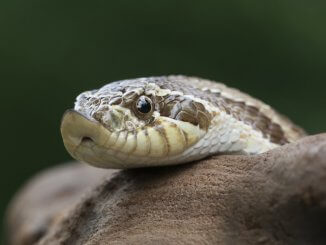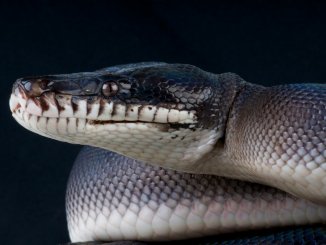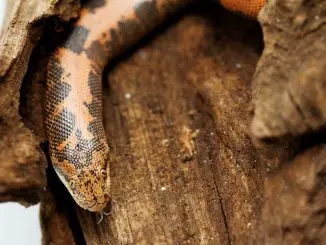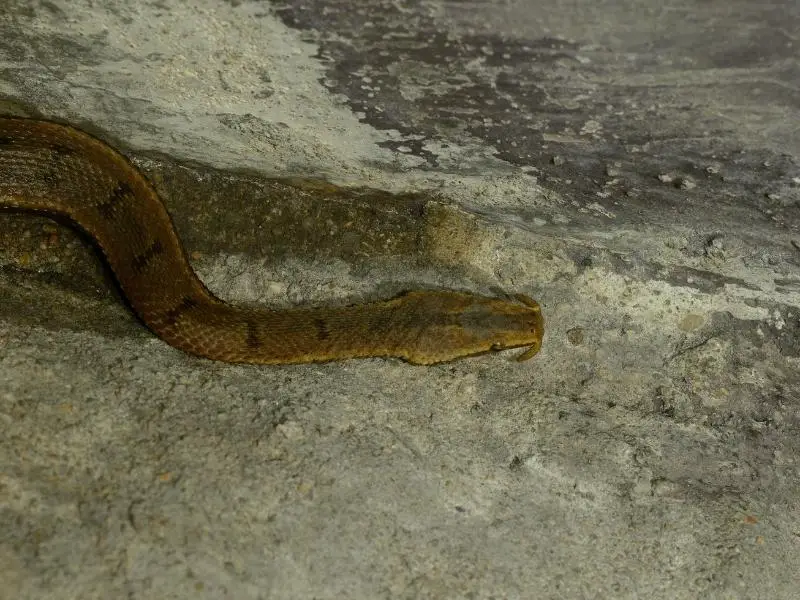
The tentacled snake is a small, slim, flat-headed snake with rear fangs and facial tentacles. Tentacled snakes originate in Southeast Asia and are found in shallow waters, where they hunt for fish, frogs, and crabs.
Tentacled snakes are moderately difficult to care for and are best as display-only pets because this species becomes stressed in incorrect or fluctuating water conditions and is mildly venomous.
Tentacled Snake Overview
| Common name | Tentacled snake, tentacle snake |
| Scientific name | Erpeton tentaculatum |
| Natural habitat | Streams, ditches, and brackish water in Vietnam, Thailand, and Cambodia |
| Adult size | 20–30 inches |
| Average lifespan | 10–20 years |
| Diet | Carnivore |
| Housing | Minimum 20 gallons, 77–82°F, 55%–60% humidity |
| Experience | Moderate |
Origin
The tentacled snake (Erpeton tentaculatum) originates in the murky, shallow, relatively warm waters of rice paddies, lakes, and slow-moving streams in Asia.
Tentacled snakes are adapted to live in brackish, fresh, and seawater. The snakes are nocturnal and spend most of their time lying in the weeds in the water, waiting to catch prey that swims by. Tentacled snakes aren’t considered endangered or threatened in the wild.
Appearance and Behavior
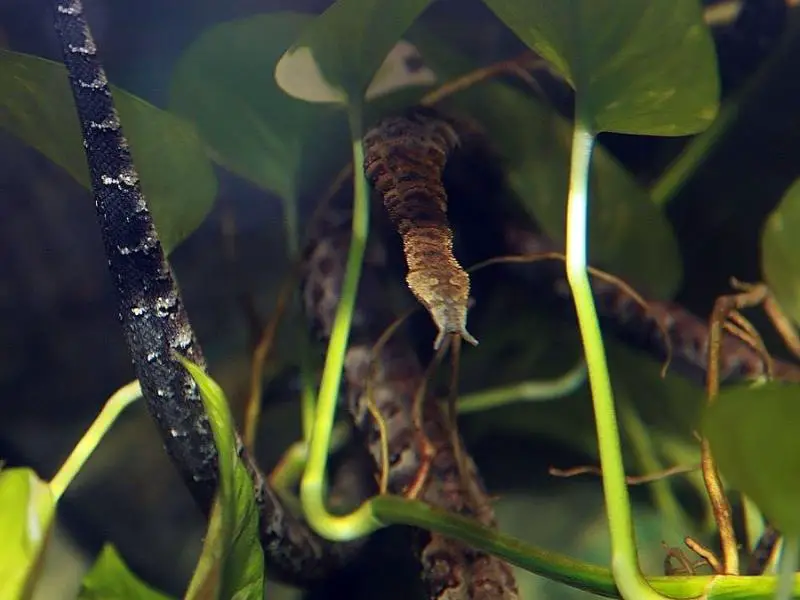
The tentacled snake has a small, slim body with rough scales and a flat head. The snake is found in two common colors: dark gray with light brown mottling, and light brown with dark stripes. The snake’s colors and markings act as camouflage, giving the snake the appearance of a twig or a branch rather than a snake lying in wait for its prey.
Tentacled snakes are so-called due to their two small tentacles, found on the tip of the snout, which act as sensory organs and are thought to help the snakes locate their prey. The snakes have small fangs found in the rear of the mouth, which release venom to stun small prey animals.
Tentacled snakes aren’t sexually dimorphic, so males and females have no obvious differences in size or physical features.
Size and Lifespan
Tentacled snakes are small snakes, averaging 20 to 30 inches long. In the wild, some snakes grow to 35 inches long.
The average lifespan of a tentacled snake is 14 years. In captivity, a snake of this species should live for at least 10 years, with an average maximum lifespan of 20 years.
Temperament
The tentacled snake is an active snake that spends most of its time swimming around the tank or lurking in hiding spots, hunting for prey. Several tentacled snakes can be housed together in a large tank because this species isn’t known to be aggressive or territorial.
Tentacled snakes are aquatic species. They’re nearly helpless on land and most of their time underwater. The snakes are docile and can be handled, but infrequent handling is recommended because this species becomes stressed when taken out of the water. A cramped or unclean tank environment is also known to stress tentacled snakes.
Housing Tentacled Snakes
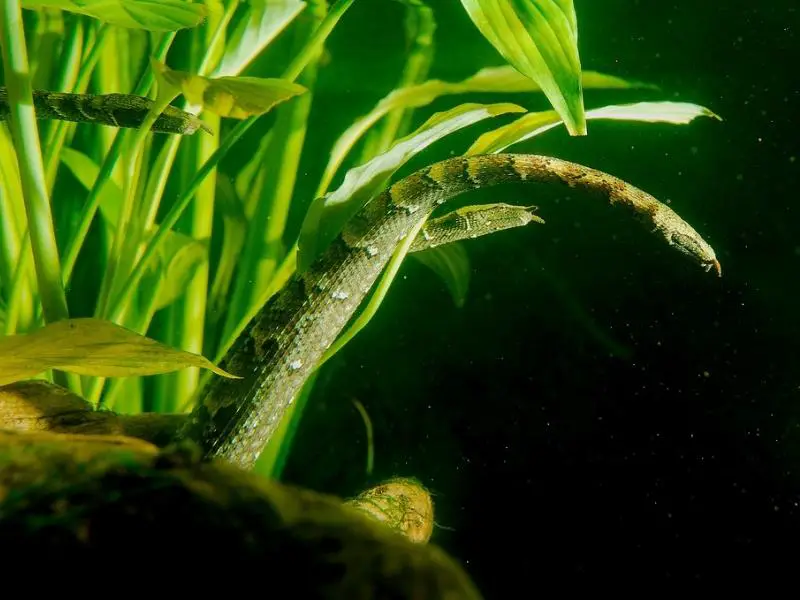
The tentacled snake’s natural habitat is murky, slow-moving waters in humid regions. To ensure the snake is happy and comfortable in captivity, set up a secure, water-based tank that offers plenty of swimming space. The best type of enclosure for a tentacled snake is a glass aquarium.
Enclosure size
The required enclosure size for a single tentacled snake is 20 gallons. A group of three or more tentacled snakes needs a 55-gallon tank or larger. The ideal water depth in a tentacled snake’s tank is 6 to 12 inches. The snakes swim to the surface of the water to breathe, so they don’t need land space.
Lighting
Tentacled snakes require a standard day-to-night light cycle in captivity, which can be achieved by placing the tank in a room that receives natural light from a window, or by installing artificial lighting on the underside of the tank’s lid. If you plan to add plants to the tank, install lighting even if your tank is housed in a brightly-lit room to ensure that plant life receives enough light to grow.
While tentacled snakes don’t need UVB to survive, UVB helps the snakes synthesize vitamin D and may improve the snake’s coloration and activity level. Installing UVB lighting in the enclosure is optional.
Temperature and Humidity
The required temperature range in a tentacled snake enclosure is 77 to 82°F, which mimics the natural water temperatures of the snake’s wild habitat. Use an aquarium heater to achieve the desired temperature and monitor the temperature with a thermometer. Ensure the temperature remains stable to prevent stress and disease in the tentacled snake.
The ideal humidity for a tentacled snake enclosure is 55% to 60%. The naturally occurring evaporation of water in the tank keeps the enclosure’s humidity levels balanced if the water heater is set to the correct temperature.
Substrate and Decoration
No substrate is required in a tentacled snake enclosure. However, natural, non-abrasive gravel or sand-based substrates can be used to improve the appearance of the tank. Substrate is safe to use in a tentacled snake’s enclosure because these snakes aren’t known to ingest substrate.
Provide logs, rocks, and underwater vines for the tentacled snake to anchor to while hunting. Live or artificial plants can also be used for anchoring purposes and to create a natural appearance in the tank. Tentacled snakes sleep underwater and don’t need any specific bedding.
Cleaning
Install a filter to keep the water in your tentacled snake tank constantly clean. The snakes produce a lot of waste, so a strong filter, like a submersible filter or a sump-type filter, is necessary. Regardless of the filter you use, you should also change about 25% of the water in the tank once a week to maintain hygienic conditions.
Alongside filtration, test for nitrates and ammonia every one or two weeks and ensure that there are no more than 2 ppm nitrates and 0 ppm ammonia in the water.
Every two months, empty and deep-clean the tank. Transfer your tentacled snake to a separate, water-containing tank while you clean out the main tank. Use reptile tank cleaning products to wipe down the surfaces, and soak the tank decorations in warm water. Avoid using soap or chemicals that aren’t recommended for snakes.
Tentacled Snake Care
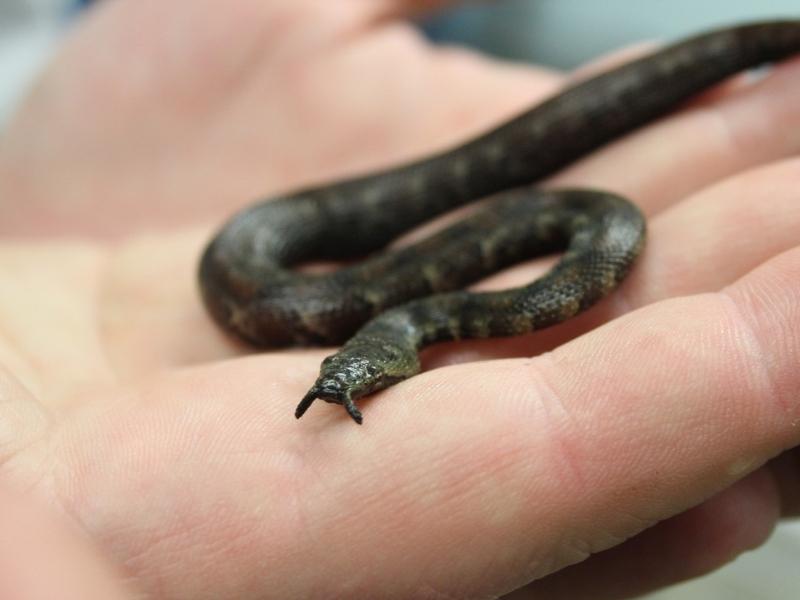
The tentacled snake is easy to care for. This snake needs a healthy, high protein diet, and clean, warm, slow-flowing water to avoid stress and disease in captivity.
Food and Water
Tentacled snakes enjoy live food, such as small feeder fish, in captivity. Bettas, rosy barbs, feeder goldfish, minnows, mollies, and guppies are all good food choices for a tentacled snake.
House a group of 30 to 50 fish in the tank, allowing the tentacled snake to feed whenever it wants to (the snakes usually eat 20 to 30 2-inch fish per week). Replenish the fish when the stock gets low.
Juvenile tentacled snakes eat the same diet as adult snakes. Make sure the feeder fish are no bigger than one-quarter of the length of the snake to prevent the fish from harming the snake.
Tentacled snakes don’t need a dedicated water bowl because they spend most of their time submerged underwater.
Handling
Tentacled snakes are docile and unlikely to bite when handled. However, the snakes may lash out if they confuse your hand for food. Handling this aquatic snake species for too long may also cause the snake to become stressed and sick.
The tentacled snake’s stomach muscles aren’t designed to bear its weight on land, so lifting a snake may cause internal injury. Only handle tentacled snakes when absolutely necessary, such as to conduct a medical examination or to transport the snake from one water-based tank to another.
Common Health Issues
Tentacled snakes are healthy, hardy snakes that aren’t prone to many health conditions. Poor living conditions are the most common cause of health issues in these snakes.
The tentacled snake is a fully aquatic species, so the snake may develop internal and external issues if it spends too much time out of the water. Prevent these injuries by ensuring the snake has constant access to water and by securing the tank lid to prevent the snake from escaping.
Fluctuating or poor-quality water conditions can also cause stress and physical health problems in the tentacled snake. High ammonia and nitrate levels in the water may poison the snake, causing symptoms like lethargy, poor feeding response, and faded color. Test for nitrate and ammonia in the water once per week and install a strong filter to remove these contaminants.
Shedding
Tentacled snakes shed their skin every few weeks to every few months, depending on their age and growth rate. The snakes grow algae on their skin, which is removed during shedding.
Remove shed skin from the water as soon as you notice it to keep the water clean.
Breeding
Tentacled snakes are challenging to breed in captivity, and not much information is available on the breeding process. Tentacled snakes become sexually mature at three to five years old and give birth to live young.
For the highest likelihood of breeding success, house three or four male and female tentacled snakes together in a healthy environment with good-quality water.
Choosing and Buying a Tentacled Snake
A tentacled snake costs $200 to $350. Tentacled snakes are usually wild-caught and imported from the US due to the difficulty in breeding this species. Look for reputable breeders who will ensure the safe transportation of the snakes, which reduces the amphibians’ risk of disease.
When choosing a tentacled snake, check that the snake has clear, alert eyes, smooth, shiny scales, and normal eating habits. Avoid snakes with signs of illness like lethargic behavior, cloudy eyes, and pus or discharge from the skin, eyes, nose, or mouth.

